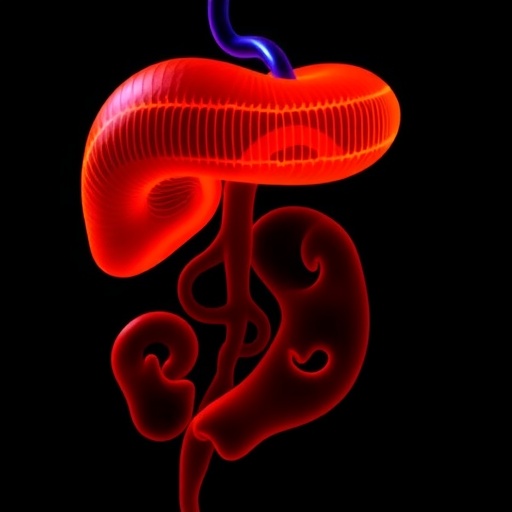The intricate biochemistry of neonatal bilirubin metabolism has intrigued researchers and clinicians for decades, yet recent findings suggest that our understanding of the underlying mechanisms remains incomplete. At the forefront of this exploration lies the enzyme UDP-glucuronosyltransferase 1A1 (UGT1A1), traditionally studied within the hepatic context. However, a groundbreaking perspective gaining momentum highlights the critical yet underappreciated role of extrahepatic expression of UGT1A1, particularly within the intestinal system, in managing neonatal bilirubin levels.
Bilirubin, a yellowish pigment produced during the normal breakdown of red blood cells, is typically metabolized in the liver. The conjugation process, mediated primarily by UGT1A1, transforms lipophilic unconjugated bilirubin into a hydrophilic form, facilitating its excretion. This process is crucial in neonates who are especially vulnerable to elevated bilirubin levels, a condition known as hyperbilirubinemia, which can lead to severe complications like kernicterus if unchecked. Historically, hepatic UGT1A1 activity was considered the central avenue for bilirubin clearance. Nonetheless, emerging evidence prompts a reevaluation of this paradigm by focusing on the potential metabolic contributions of the intestine.
The article by J.F. Watchko, published in Pediatric Research in 2025, advocates for a reassessment of bilirubin metabolism by shedding light on the intestinal expression of UGT1A1. This enzyme’s extrahepatic presence suggests a dual-site system where the intestine does more than merely reabsorb nutrients; it participates actively in detoxifying bilirubin. Such insights are critical, given the variable expression and activity levels of UGT1A1 in neonates that may explain disparities in susceptibility to bilirubin-induced neurotoxicity.
In neonates, hepatic enzymatic pathways are immature and insufficient for managing bilirubin loads, making extrahepatic mechanisms all the more critical. The intestinal epithelium, which develops rapidly postnatally, expresses UGT1A1 at levels that may significantly contribute to bilirubin conjugation. This intestinal conjugation might minimize the biliary and hepatic burden during the vulnerable neonatal period and represents an adaptive metabolic strategy until hepatic function matures fully.
From a molecular standpoint, the enzymatic kinetics of intestinal UGT1A1 exhibit intriguing characteristics. The intestinal isoform shows substrate affinities and cofactor dependencies that differ subtly from hepatic UGT1A1, reflecting tissue-specific regulation. Such biochemical nuances could underlie why some neonates handle bilirubin loads effectively despite minimal hepatic UGT1A1 activity, suggesting that the intestine compensates through localized conjugation and possibly excretion into the gut lumen.
Moreover, the interaction between intestinal microbiota and UGT1A1-mediated bilirubin metabolism unfolds a fascinating dimension. Gut bacteria influence the enterohepatic circulation of bilirubin and its metabolites, and the passive or active excretion of conjugated bilirubin into the intestine presents opportunities for microbial modification. This interplay may modulate both systemic bilirubin levels and local gut health, implicating a complex host-microbiome-metabolite axis not previously considered in neonatal care strategies.
Clinically, these revelations underscore the importance of maintaining intestinal integrity and function in newborns at risk of hyperbilirubinemia. Disruptions to the gut barrier or dysbiosis could impair extrahepatic bilirubin conjugation, exacerbating systemic accumulation. Therapeutic interventions targeting the enhancement of intestinal UGT1A1 expression, or modulating gut microbial populations to favor bilirubin clearance, could open new frontiers in preventing neonatal jaundice complications.
The developmental regulation of intestinal UGT1A1 expression is another critical aspect. Genetic and epigenetic factors influencing enzyme levels may account for the heterogeneous clinical presentations of neonatal hyperbilirubinemia. For instance, polymorphisms within regulatory regions or environmental exposures affecting gene expression during early infancy might modulate the enzyme’s intestinal activity. Understanding these regulatory mechanisms at a molecular level could refine risk stratification and individualized treatment approaches.
Furthermore, animal models and in vitro studies underscore the significance of intestinal UGT1A1. Transgenic mice deficient in hepatic UGT1A1 but expressing the enzyme intestinally exhibit ameliorated bilirubin profiles compared to total knockouts, reflecting the intestine’s compensatory role. These experimental systems provide crucial insights into the enzyme’s functional dynamics outside the liver and offer platforms for testing pharmaceutical modulation strategies.
Translating these findings into clinical diagnostics involves exploring biomarkers indicative of extrahepatic UGT1A1 activity. Non-invasive assessment tools that reflect intestinal conjugation capacity may help identify neonates at higher risk for bilirubin accumulation. Such biomarkers, coupled with precise imaging or biochemical assays, could revolutionize the monitoring and management of neonatal jaundice.
The current understanding also invites a reevaluation of common neonatal care practices, such as phototherapy. While phototherapy remains a cornerstone treatment by converting bilirubin into water-soluble isomers, acknowledging intestinal UGT1A1’s role may inspire adjunct treatments that synergize with existing modalities. Enhancing enzymatic conjugation in the intestine could potentially reduce phototherapy duration or intensity, minimizing associated risks.
On a broader scale, this paradigm shift challenges the hepatocentric dogma and encourages a holistic view of bilirubin metabolism encompassing multiple organ systems. It aligns with an emerging trend in biomedical science recognizing the integrated nature of metabolic pathways and the importance of tissue cross-talk, particularly in delicate developmental windows such as the neonatal period.
In conclusion, the spotlight on extrahepatic intestinal UGT1A1 signals a transformative phase in neonatal bilirubin research. This expanded perspective promises deeper mechanistic insights, novel therapeutic targets, and ultimately improved outcomes for newborns worldwide. As the scientific community continues unraveling these complex biochemical networks, the hope is to mitigate the global burden of neonatal hyperbilirubinemia through informed, multi-faceted interventions grounded in cutting-edge molecular science.
The work by Watchko not only clarifies a critical metabolic puzzle but also catalyzes future research aimed at integrating hepatology, gastroenterology, microbiology, and neonatology. The convergence of these disciplines around the central theme of bilirubin metabolism may well herald new horizons in pediatric care, ensuring that the earliest moments of life are safeguarded by precision medicine rooted in a thorough understanding of enzymatic orchestration beyond the liver.
Subject of Research: The role of extrahepatic intestinal UGT1A1 in human neonatal bilirubin metabolism.
Article Title: Time to clarify the role of extrahepatic intestinal UGT1A1 in human neonatal bilirubin metabolism.
Article References:
Watchko, J.F. Time to clarify the role of extrahepatic intestinal UGT1A1 in human neonatal bilirubin metabolism. Pediatr Res (2025). https://doi.org/10.1038/s41390-025-04090-1
Image Credits: AI Generated
Tags: bilirubin conjugation processbilirubin excretion mechanismsextrahepatic UGT1A1 expressionhyperbilirubinemia in neonatesintestinal bilirubin clearancekernicterus preventionmetabolic contributions of the intestineneonatal bilirubin metabolismneonatal liver functionpediatric bilirubin managementUDP-glucuronosyltransferase roleUGT1A1 research advancements




